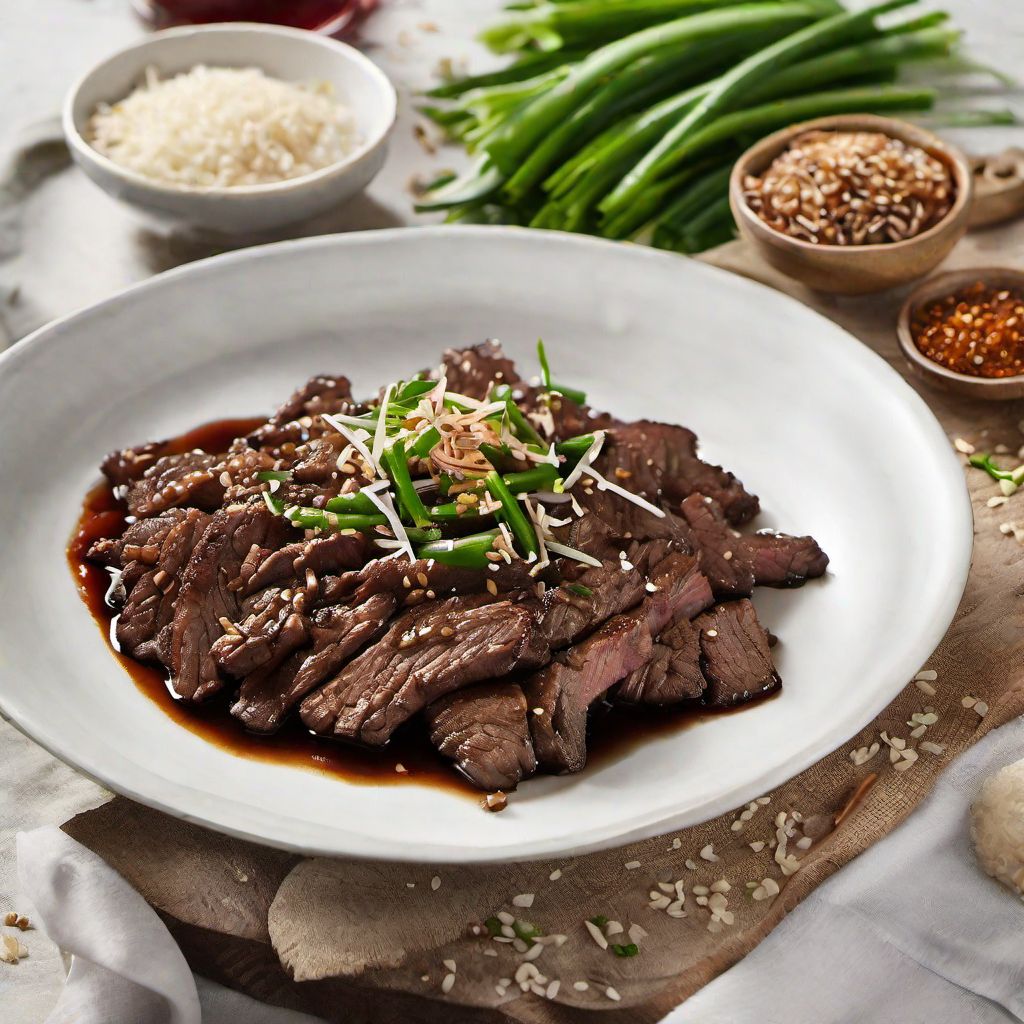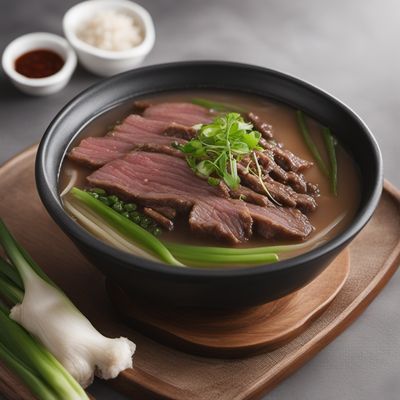
Recipe
Bulgogi Bavarian Style
Bavarian Bulgogi: A Fusion of Korean and German Flavors
4.8 out of 5
In the context of Bavarian cuisine, this recipe adapts the traditional Korean dish of Bulgogi. Bavarian cuisine is known for its hearty and flavorful dishes, and this fusion recipe brings together the tender marinated beef of Bulgogi with the rich and savory flavors of Bavarian cuisine. Get ready to experience a unique blend of Korean and German culinary traditions!
Metadata
Preparation time
15 minutes
Cooking time
10 minutes
Total time
25 minutes
Yields
4 servings
Preparation difficulty
Medium
Suitable for
Omnivore, Low-carb, High-protein, Gluten-free, Dairy-free
Allergens
Mustard, Soy
Not suitable for
Vegetarian, Vegan, Paleo, Keto, Nut-free
Ingredients
While the original Korean Bulgogi is typically made with thinly sliced beef marinated in a soy-based sauce, this Bavarian adaptation incorporates elements of German cuisine. The marinade is enhanced with the addition of Bavarian beer, mustard, and caraway seeds, giving the dish a distinct Bavarian twist. The beef is still the star of the dish, but the flavors are elevated with the infusion of traditional Bavarian ingredients. We alse have the original recipe for Bulgogi, so you can check it out.
-
500g (1.1 lb) beef sirloin, thinly sliced 500g (1.1 lb) beef sirloin, thinly sliced
-
1/2 cup (120ml) Bavarian beer 1/2 cup (120ml) Bavarian beer
-
3 tablespoons soy sauce 3 tablespoons soy sauce
-
2 tablespoons brown sugar 2 tablespoons brown sugar
-
2 tablespoons Bavarian mustard 2 tablespoons Bavarian mustard
-
1 tablespoon sesame oil 1 tablespoon sesame oil
-
1 tablespoon caraway seeds 1 tablespoon caraway seeds
-
4 cloves garlic, minced 4 cloves garlic, minced
-
1 onion, thinly sliced 1 onion, thinly sliced
-
2 green onions, chopped 2 green onions, chopped
-
1 tablespoon vegetable oil 1 tablespoon vegetable oil
-
Salt and pepper, to taste Salt and pepper, to taste
Nutrition
- Calories (kcal / KJ): 350 kcal / 1465 KJ
- Fat (total, saturated): 15g, 4g
- Carbohydrates (total, sugars): 10g, 6g
- Protein: 40g
- Fiber: 2g
- Salt: 2g
Preparation
-
1.In a bowl, combine the Bavarian beer, soy sauce, brown sugar, Bavarian mustard, sesame oil, caraway seeds, minced garlic, and sliced onion. Mix well to create the marinade.
-
2.Add the thinly sliced beef to the marinade, ensuring that all the slices are coated. Cover the bowl and refrigerate for at least 2 hours, or overnight for maximum flavor.
-
3.Heat the vegetable oil in a large skillet or grill pan over medium-high heat.
-
4.Remove the beef from the marinade, allowing any excess marinade to drip off. Reserve the marinade for later use.
-
5.Cook the beef in batches, ensuring not to overcrowd the pan. Sear the beef slices for 2-3 minutes on each side, or until they are browned and cooked to your desired level of doneness.
-
6.Pour the reserved marinade into the pan and cook for an additional 2-3 minutes, allowing the flavors to meld together.
-
7.Sprinkle the chopped green onions over the cooked beef and toss gently to combine.
-
8.Season with salt and pepper to taste.
-
9.Serve the Bavarian Bulgogi hot with your choice of side dishes.
Treat your ingredients with care...
- Beef — Choose a tender cut of beef like sirloin for the best results. Slice it thinly against the grain to ensure tenderness.
- Bavarian beer — Opt for a malty and flavorful Bavarian beer to enhance the marinade. A lager or wheat beer works well.
- Bavarian mustard — Use a good quality Bavarian mustard for its distinctive flavor. Dijon mustard can be used as a substitute if Bavarian mustard is not available.
- Caraway seeds — Toast the caraway seeds lightly in a dry pan before adding them to the marinade. This will release their aromatic oils and enhance their flavor.
Tips & Tricks
- For a smoky flavor, you can grill the marinated beef instead of cooking it in a skillet.
- Serve the Bavarian Bulgogi with traditional Bavarian sides like sauerkraut, pretzels, or potato dumplings.
- If you prefer a spicier version, add a teaspoon of Bavarian sweet mustard or a pinch of cayenne pepper to the marinade.
- Leftover Bavarian Bulgogi can be used as a filling for sandwiches or wraps.
- Adjust the sweetness of the dish by adding more or less brown sugar to the marinade according to your taste preference.
Serving advice
Serve the Bavarian Bulgogi hot, garnished with additional chopped green onions. Accompany it with a side of sauerkraut and freshly baked pretzels for an authentic Bavarian experience.
Presentation advice
Arrange the cooked beef slices on a platter and drizzle some of the reserved marinade over the top. Sprinkle with chopped green onions for a pop of color. Serve with a side of sauerkraut and pretzels to complete the Bavarian presentation.
More recipes...
For Bulgogi » Browse all
For Korean cuisine » Browse all
More Korean cuisine dishes » Browse all

Toyga
Tofu soup
Toyga is a traditional Azerbaijani soup made with lamb and vegetables.

Gyeran mari
Korean rolled omelette
Gyeran mari is a Korean dish that is made with rolled eggs. It is a popular breakfast dish that is easy to make and delicious to eat.

Galmaegisal
Galmaegisal (pork dish)
Galmaegisal is a Korean dish made with grilled pork skirt steak.











